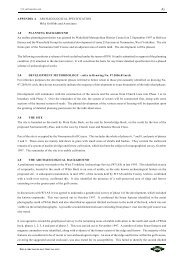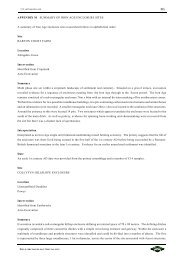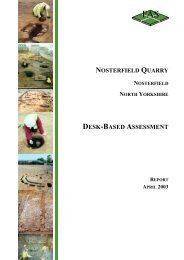ARCHAEOLOGICAL EVALUATION - Mike Griffiths and Associates
ARCHAEOLOGICAL EVALUATION - Mike Griffiths and Associates
ARCHAEOLOGICAL EVALUATION - Mike Griffiths and Associates
You also want an ePaper? Increase the reach of your titles
YUMPU automatically turns print PDFs into web optimized ePapers that Google loves.
FAS_lbf01.wpd 161<br />
c.40.70m AOD to c.40.50m at the western end. The ploughsoil, C1123, consisted of an homogenous yellowishbrown<br />
gravelly clayey silt <strong>and</strong> measured between 0.30-0.40m in depth. The surface of subsoil C1124 reflected<br />
ground level topography <strong>and</strong> consisted of an orangish-brown gravel <strong>and</strong> clayey silt with areas of more brown<br />
clayey silt.<br />
A single feature was identified within Intervention 40 <strong>and</strong> allocated F51 (Figure 104). This was first defined<br />
as a small circular deposit of dark grayish brown s<strong>and</strong>y silt measuring c.0.33m in diameter. Upon excavation<br />
the feature was revealed to be a very shallow scoop no greater than 0.03m deep (Figure 105). A single backfill<br />
was contained within F51 which consisted of a clean dark greyish-brown s<strong>and</strong>y silt with inclusions of very rare<br />
gravel, charcoal <strong>and</strong> iron-rich mineralised staining. The feature was interpreted as a truncated possible pit; no<br />
dateable material was recovered during excavation.<br />
8.2.35 Intervention 41<br />
Intervention 41 was situated close to the northern boundary of<br />
Zone A (see Figure 36) <strong>and</strong> measured 50m x 4m, being<br />
orientated north-south (Plate 49). The local ground level was<br />
highest at the northern end at c.40.50m AOD sloping down by<br />
0.50m to southern end. Ploughsoil C1123 measured between<br />
0.30 <strong>and</strong> 0.50m in depth, <strong>and</strong> overlay the natural subsoil C1124<br />
which reflected ground level topography. C1124 was<br />
predominantly a well-drained orangish-brown gravel <strong>and</strong> clayey<br />
silt with areas of light grey gravel throughout the trench.<br />
No features were defined within Intervention 41.<br />
Plate 49 Intervention 41 looking north (scale<br />
2m)<br />
8.2.36 Intervention 42<br />
Intervention 42 was situated within Zone E to the east of the<br />
main evaluation area (see Figure 36). The machine-excavated<br />
trench measured 100m x 4m <strong>and</strong> was orientated east-west (Plate<br />
50). Ground level was highest at the centre of the trench at<br />
c.41.80m AOD sloping down by 0.50m to the west <strong>and</strong> 0.20m<br />
to the east. Ploughsoil C1123 consisted of a yellowish-brown<br />
clayey silt with gravel <strong>and</strong> pebbles <strong>and</strong> was found to be 0.30-<br />
0.40m in depth throughout the trench. The surface of the<br />
natural subsoil C1125 reflected ground level topography <strong>and</strong><br />
consisted of a predominantly mid-brown gravel <strong>and</strong> clayey silt<br />
with b<strong>and</strong>s of light grey clayey silt running through the trench.<br />
Plate 50 Intervention 42 looking west (scale<br />
2m)<br />
A single feature was identified within Intervention 42 <strong>and</strong> was allocated F53 (Figure 106). F53 first appeared<br />
as an apparently linear deposit of dark yellowish-brown silty s<strong>and</strong> orientated approximately north-south. Upon<br />
excavation the feature was found to be a variation in the natural subsoil system <strong>and</strong> was not archaeological in<br />
FIELD ARCHAEOLOGY SPECIALISTS







